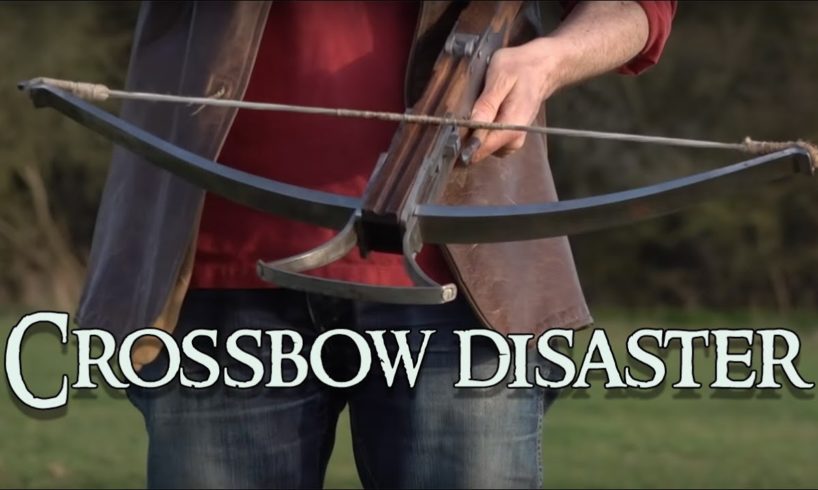
Jason Kingsley, the Modern Knight, investigates a medieval 1000lbs draw weight siege crossbow and finds out what can go very wrong! #medieval #crossbow #weapon
Join this channel to get access to perks:
https://www.youtube.com/channel/UCMjlDOf0UO9wSijFqPE9wBw/join
source



![有趣的猫.funny cats] #猫 #小猫#猫動画 #小猫#小猫咪运动 #小猫咪能有什么坏心眼 #小猫咪 #小猫症 #小猫咪节点 #shorts #cat](https://www.theviralist.com/wp-content/uploads/2024/04/有趣的猫funny-cats-猫-小猫猫動画-小猫小猫咪运动-小猫咪能有什么坏心眼-小猫咪-小猫症-小猫咪节点-shorts-300x200.jpg)


![口渴的猫.cats] #subscribe #shorts #cat #猫 #小猫#猫動画 #小猫#小猫咪运动 #小猫咪能有什么坏心眼 #小猫咪 #小猫症 #小猫咪节点 ](https://www.theviralist.com/wp-content/uploads/2024/04/口渴的猫cats-subscribe-shorts-cat-猫-小猫猫動画-小猫小猫咪运动-小猫咪能有什么坏心眼-小猫咪-小猫症-300x200.jpg)
Really hoping to see the impact of bolt on shield from a 1000lb draw.
A fact not considered in here is height. I assume crossbows are more of a defensive weapon maybe used on sieges. Probably while shooting it from higher ground would cover that range difference.
This video was awesome, but I will say the sound of the crossbow shooting caught me off guard. I expected like a cool fwoosh sound… not a doink 😅. I’ve watched too many movies
Strange. A standard distance in competitive shooting for a regular bow is 50 meters. I've shot up to 100 meters. 109 yards. That is at 40 lbs pull. A 1000 lbs. pull crossbow can't manage that?
Could a crossbow be effective as a melee weapon.
I never knew about the windlass before, and a crossbow seemed like such a faff even without one – but i guess it shows JUST how deadly it really was, when successful, that it was still used despite all these drawbacks. Love these videos; brings the people before us back to life ❤️
Crossbowzooka
Well, I didn't major in physics. But I noticed your arc or the trajectory was very steep. If your arc is steep enough you could make the bolt land fifty feet in front of you. I wonder if you flattened your arc that you might actually get a longer distance.
What if you grease the stribg and crossbow for less friction?
This is fascinating stuff here and I am new to all this but have a question.
There doesn't seem to be any question of accuracy between this weapon and a long bow so the guy firing the crossbow is not the biggest threat on the battlefield, right?
Who is? Who does the enemy go after first?
I am guessing that it would be the guy on the horse or the general or the bowman.
The crossbow was never about accuracy or effectiveness, they were made because they were able to be used by anyone who can look to aim and pull the trigger. Longbows were better but took training and strength.
I do wonder how much the wind seamed to have affected the outcome of the shot length. Based on the flag next to you, it seams the wind was blowing towards and a little bit to your left. And the bolt did land a bit to the left of your target. However I don't know the wind or where you where aiming.
You're shooting into the wind mate. you can see by the flag, breezy day. Besides, the bolt is much lighter than an arrow. It's not designed for distance shooting.
if u increase 3,4 times the weight of the arrow, the speed will remain almost the same
efficiency will be increased
Good video. A shame that you were not able to test the penetrating power and affective range but still an informative video.
21 min vid.. dident destroy anythin with it and only shot it 3 times… get recking dude cmon
You dummy, your sposed to used wax for the string and rail lube for the rail, in old times they used animal fat and oil from plants and animals, or oil from the ground, it wouldnt of frade if you put wax on the string and fat or greese on the rail
The alternate universe if Braveheart didn’t become an antisemite!
Mate. Metric. Use it.
why the hell would u expect to go 200 yards when u aim it straight up?
so user error makes it bad. got it.
they probably had multiple crossbows pre loaded as well
fires it
Jerry from the next town Over probably won't like that in his lawn
Interesting video. Btw For info – the angle should probably be less than 45 degrees (45 ignores drag caused by air resistance). Wind direction also affects the optimal angle (following wind increases the angle etc).
I wonder if Eddie Hall could oull the string back. he liftet 500 kilograms, so in theory it should be possible xD
That’s an expensive crossbow
When you need something for self defence in ingerland
An uneducated guess to why it's underperforming: your trigger catch is broken in some way, leading to a heavier than normal trigger pull, and fraying on your line (perhaps due to only partial trigger drop, and snagging occurring).
My first and main thought with this is that you would be up on a battlement. However, no one has mentioned multiple people (or crossbows.) I imagine them having a pile of loaded crossbows to fire. Or at very least a rotation of 2 or 3 men. One man does the firing and has a "loaded" bow handed to him after every shot. The other two men load from safety and their timing is slightly staggered. 5-8 seconds to choose target, aim, loose; and 2-4 seconds per crossbow swap would avail both loaders adequate time on their respective "turn"
As excusable as it is, it's still cute how Britons don't intuitively know how big an inch is.
Typically around 60 paces = 100m, so 120-130 paces is about 200-220m. It depends a little on your height and gait, but in the infantry we spent a day during map-reading to get our pace, and it was pretty close to 60 for almost all of us (55-70) per 100m.
If you mean 'steps' rather than 'paces' (a pace is two steps, every time your right foot hits the ground), 130steps is only 100 m or so, but 130 paces is probably a little over 200 m more if you have a long stride.